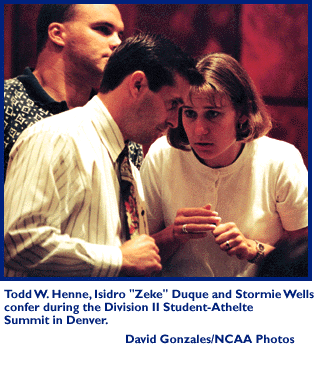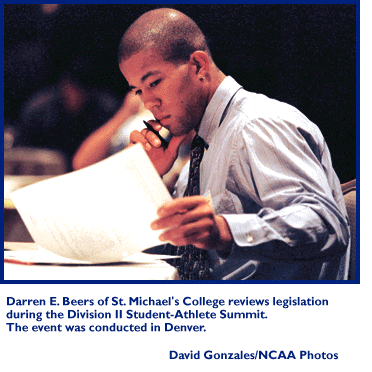The NCAA News - News and FeaturesAugust 18, 1997
Participants are pleased with first athlete summit
BY JACK L. COPELAND
Staff Writer
DENVER -- Administrative and student leaders came away from the first Division II Student-Athlete Summit enthusiastic about the method they have created for helping student-athletes be involved in the Division II governance process.
 The summit, held July 27 in conjunction with the first official meeting of the Division II Management Council July 28-29, brought together Management Council and Division II Student-Athlete Advisory Committee (SAAC) members for one-on-one discussions of issues and concerns.
The summit, held July 27 in conjunction with the first official meeting of the Division II Management Council July 28-29, brought together Management Council and Division II Student-Athlete Advisory Committee (SAAC) members for one-on-one discussions of issues and concerns.
Two representatives of the Division II Presidents Council -- chair Adam W. Herbert and SAAC liaison Marvalene Hughes -- also participated in the summit.
The summit produced its first recordable results just one day later, when the Management Council agreed to form a project team to explore specific issues raised by student-athletes.
Those issues include further ensuring student-athlete participation in Division II governance and establishing appropriate eligibility criteria for serving on the Division II SAAC. Representatives of the Management Council, Presidents Council and SAAC will serve on the project team.
Unique approach
The issues assigned to the project team were primary topics of discussion during the summit -- which was established as a unique approach within the Association to student-athlete participation in governance.
During the recent transition to the new governance structure, Divisions I and III agreed to include student-athletes as members of their Management Councils. The two student-athletes on the Division III Management Council are voting members of that body; two student-athletes also participate in meetings of the Division I Management Council but do not have a vote.
Division II, however, opted to schedule the annual summit rather than provide representation on the Management Council. The theory behind the summit is that the 24 members of the SAAC can be more influential during a daylong, face-to-face meeting with the 24 members of the Management Council than they can as only one or two individuals in Management Council meetings.
The SAAC is the only general committee that is guaranteed an opportunity to meet face-to-face with the Management Council in the Division II governance structure.
Still, during the months after the summit approach was adopted, members of what was then an Association-wide Student-Athlete Advisory Committee pressed for actual representation on the Division II Management Council. Summit participants arrived in Denver expecting this to be the stickiest issue of the day.
 "Coming in, we were strong in our opinions," said student-athlete Dan O'Callahan of Rollins College, who cochaired the summit with Management Council vice-chair Clint Bryant.
"Coming in, we were strong in our opinions," said student-athlete Dan O'Callahan of Rollins College, who cochaired the summit with Management Council vice-chair Clint Bryant.
In the summit's opening discussion, SAAC members asked for a vote on the Management Council, and then listened as Management Council members expressed concerns that such representation might give a single Division II league too much leverage in a governance body whose structure is based on conference representation.
The large group then broke into smaller discussion groups, and participants began to focus on the fact that many institutions have not yet formed campus student-athlete advisory committees required under NCAA legislation and that many Division II leagues have not established a conference-level mechanism for student-athlete input (see accompanying story).
Consensus emerges
A consensus began to emerge from those face-to-face discussions: Maybe it's too early for student-athletes to become voting participants in the Management Council, because there is not yet a structure that ensures effective representation of student-athlete views. Instead, Division II should focus on developing what is now only a patchy network of campus and conference student-athlete advisory groups into an effective, grassroots network.
"Maybe the most important thing to do now is establish conference and institutional student-athlete advisory committees, and then go from there," O'Callahan said afterward.
That consensus led to another Management Council action the next day. It recommended to the Division II Presidents Council that it sponsor proposed legislation at the 1998 Convention to require the establishment of conference student-athlete advisory committees.
It also instructed the newly formed project team to consider various ways of ensuring that student-athletes can participate in governance discussions beyond the summit -- possibly including attendance of student-athletes at Management Council and Presidents Council meetings.
And Management Council members also agreed individually to assume responsibility for maintaining regular, one-on-one contact with the student-athlete representatives from their conferences.
A week after the summit, Bryant of Augusta State University already had contacted R. Greg Clark of Kennesaw State University, the Peach Belt Athletic Conference's SAAC representative, to share information about the Management Council meeting.
"We as Council members made a commitment to have a dialogue with our conference representatives," Bryant said. "Personally, I plan to talk with (Clark) before and after each Management Council meeting, and I hope he'll do so before and after each Student-Athlete Advisory Committee meeting."
Division II Management Council Chair Lynn L. Dorn said members are taking that responsibility seriously, even going so far as to list specific ways in which they will communicate and seek views from student-athletes and will aid the process of establishing conference-level student-athlete advisory groups.
"Each of us accepted responsibility as Management Council members to open the lines of communication," Dorn said.
"I was very pleased with the total commitment to make this work."
Eligibility criteria
If there was a surprise at the summit, it may be that student-athlete representation on the Management Council turned out to be a less controversial issue than the question of who should be allowed to serve as SAAC members.
Division II adopted legislation at the 1997 Convention limiting SAAC membership to current or former Division II student-athletes who are enrolled as an undergraduate or graduate student at a Division II institution. That is a change from the eligibility criteria for membership on the former Association-wide SAAC, on which student-athletes could serve for up to two years after completion of athletics eligibility -- regardless of enrollment status.
Division II SAAC members asked the Management Council to support relaxation of the new eligibility requirement. They cited several reasons: a desire to become experienced and effective representatives, a need to provide mentorship for new SAAC representatives and, more generally, a desire to "give something back" to intercollegiate athletics even after they no longer are enrolled at a Division II institution.
"I needed time to grow and be OK as a player," former volleyball student-athlete Stormie Wells of the University of Northern Colorado said during the discussion. She urged the Management Council to give SAAC members a comparable opportunity to develop as student-athlete representatives.
Management Council members responded with concerns that former student-athletes who no longer are enrolled at a Division II institution may be too far removed from current student-athletes to be truly representative of their interests.
The administrators and student-athletes reached no consensus, but the Management Council agreed during its meeting the following day to refer the issue to the project team for further consideration.
"I think we moved them on the eligibility issue," O'Callahan said following the summit.
Bryant said the student-athletes' views had an impact. "We thought enough of what the student-athletes had to say that we felt compelled to create a project team and address the issues they brought up," he said.
Review of legislation
While much of this first meeting with student-athletes focused on their role in division governance, future summits likely will concentrate more on discussion of proposed legislation.
Summit participants did set aside some time to discuss proposals for the 1998 Convention, and that discussion revealed benefits of the summit format.
A primary benefit, according to Management Council Vice-Chair Bryant, is that administrators can hear a variety of views on a given legislative topic.
He noted discussion of a Committee on Competitive Safeguards and Medical Aspects of Sports proposal to place further limits on player contact in spring football practice. The purpose of the proposal is to reduce the risk of injury to football student-athletes.
An influential view on the subject was offered by softball player Elizabeth Pelezo of Delta State University, who also serves at the institution as a student athletic trainer. She illustrated for summit participants how injuries occur during spring football practice and how the competitive-safeguards committee's proposal will address those patterns of occurrence.
"I got such insight into that situation," Bryant said following the summit, adding that he may not have gotten the same picture from meeting with only one or two student-athletes.
Participants pleased
As the summit ended, the clearest consensus to emerge was this: Everyone involved likes it.
"I was very pleased with the openness of the summit," O'Callahan said. He admitted arriving in Denver with some apprehension -- "I didn't know what to expect" -- but came away believing that an honest exchange of views occurred and that Management Council members listened to the student-athletes.
Dorn had a similar reaction from an administartor's perspective.
"It was much more interactive than what I anticipated," she said of the discussions with student-athletes.
The participating student-athletes encouraged continuation of the summit even if student-athletes eventually obtain representation on the Management Council or Presidents Council.
Management Council members came away impressed with the caliber of student-athletes who are representing Division II conferences in the new governance structure. They lauded the student-athletes' knowledge, maturity, sincerity, willingness of offer opinions, and ability to listen and learn.
And Division II leaders think they may have settled on a model of student-athlete involvement in governance that can serve as a model for the Association.
"If the first summit is any indication of where we're headed, I think we may have the best model of student-athlete representation," Bryant said.
Presidents Council Chair Herbert believes the summit accomplishes several Division II goals: It demonstrates to student-athletes the importance placed on their active involvement in division governance and establishes a mechanism for identifying concerns and problems.
He said the inaugural summit also created a common sense of purpose in building an inclusive governance structure, and that the gathering was the final piece needed to make the Division II structure "operational."
"I think this is going to emerge as one of the most exciting initiatives the Association has taken, in terms of bringing student-athletes into the mainstream of the governance process," Herbert said.
NCAA rules require campus advisory panelParticipants in the first Division II Student-Athlete Summit noted that a significant number of Division II institutions have not yet formed campus student-athlete advisory committees, despite legislation adopted in 1994 requiring their creation.
NCAA Constitution 6.1.4 requires that "each institution shall establish a student-athlete advisory committee for its student-athletes. The composition and duties of the committee shall be determined by the institution."
All NCAA institutions received a memorandum last fall from Executive Director Cedric W. Dempsey offering the Association's assistance in establishing campus committees. A brochure providing information on the concept and basics of a student-athlete advisory committee was enclosed with the memorandum.
Institutions seeking additional information on the formation of campus committees -- including guidelines and models -- can contact the education outreach staff at the NCAA national office.
|